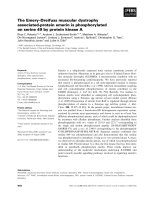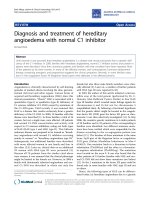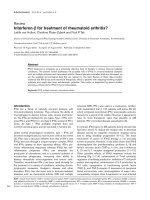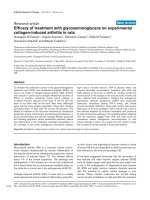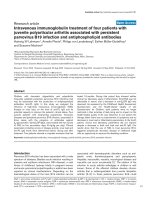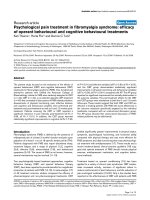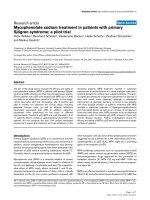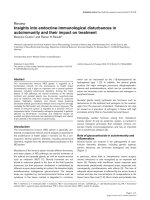Báo cáo y học: " Salmeterol/fluticasone stable-dose treatment compared with formoterol/budesonide adjustable maintenance dosing: impact on health-related quality of life" potx
Bạn đang xem bản rút gọn của tài liệu. Xem và tải ngay bản đầy đủ của tài liệu tại đây (342.37 KB, 7 trang )
BioMed Central
Page 1 of 7
(page number not for citation purposes)
Respiratory Research
Open Access
Research
Salmeterol/fluticasone stable-dose treatment compared with
formoterol/budesonide adjustable maintenance dosing: impact on
health-related quality of life
David B Price*
1
, Angela E Williams
2
and Sally Yoxall
2
Address:
1
Department of General Practice and Primary Care, University of Aberdeen, Foresterhill Health Centre, Westburn Road, Aberdeen AB25
2AY, UK and
2
Research and Development, GlaxoSmithKline, Greenford Road, Greenford, Middlesex UB6 0HE, UK
Email: David B Price* - ; Angela E Williams - ; Sally Yoxall -
* Corresponding author
Abstract
Background: Improving patients' health-related quality of life (HRQoL) is recognized as a fundamental
part of asthma management. The aims of this study were to evaluate the long-term efficacy (including
symptom-free days and exacerbations) and impact on HRQoL of a stable-dose regimen of salmeterol/
fluticasone propionate (SAL/FP) and an adjustable maintenance dosing (AMD) regimen of formoterol/
budesonide (FOR/BUD) where treatment is adjusted based on symptoms [SAM40056].
Methods: A total of 688 outpatients with asthma receiving regular low-dose inhaled corticosteroids (ICS)
plus a long-acting β
2
-agonist, or medium dose ICS alone participated in this randomized, double-blind,
double-dummy, parallel-group, 1-year trial, which was conducted in 91 centers in 15 countries. Patients
were randomized to receive 1 inhalation of SAL/FP 50/250 µg BID or 2 inhalations of FOR/BUD 6/200 µg
BID during Weeks 1–4. For Weeks 5–52, patients meeting strict continuation criteria for stable asthma at
Week 4 received AMD with FOR/BUD or stable-dose SAL/FP.
Results: The percentage of symptom-free days was significantly greater (58.8% vs 52.1%; p = 0.034) and
the annual exacerbation rate was significantly lower (47%; p = 0.008) with stable-dose SAL/FP compared
with FOR/BUD AMD. A total of 568 patients completed the Asthma Quality of Life Questionnaire
(AQLQ) at least once during the study. The mean change from baseline in AQLQ overall score was
numerically greater with SAL/FP than FOR/BUD at week 28 and week 52, but did not reach statistical
significance (p = 0.121 at Week 52). However, in a post hoc logistic regression analyses for any AQLQ
improvement, significant benefits with SAL/FP were seen at both time points (p = 0.038 and p = 0.009,
respectively). The minimally important difference of ≥ 0.5-point improvement in AQLQ overall score was
achieved by a significantly greater number of patients receiving SAL/FP at Week 28 (68% vs 60%; p =
0.049); a trend for this difference remained at Week 52 (71% vs 65%) (p = 0.205).
Conclusion: In this population of patients with persistent asthma, stable-dose SAL/FP resulted in
significantly greater increases in symptom-free days, a reduction in exacerbation rates, and provided
greater HRQoL benefits compared with FOR/BUD AMD.
Trial registration: Clinical Trials registration number NCT00479739
Published: 4 July 2007
Respiratory Research 2007, 8:46 doi:10.1186/1465-9921-8-46
Received: 5 October 2006
Accepted: 4 July 2007
This article is available from: />© 2007 Price et al; licensee BioMed Central Ltd.
This is an Open Access article distributed under the terms of the Creative Commons Attribution License ( />),
which permits unrestricted use, distribution, and reproduction in any medium, provided the original work is properly cited.
Respiratory Research 2007, 8:46 />Page 2 of 7
(page number not for citation purposes)
Background
The goals for successful management of asthma are
defined as achieving and maintaining symptom control,
preventing exacerbations, maintaining lung function as
close to normal as possible, preventing asthma mortality
and development of irreversible airflow limitation, main-
taining normal activity levels and avoiding treatment-
related adverse effects [1]. In practice, these goals are
rarely achieved and asthma control remains poor, with
many patients continuing to suffer frequent symptoms
and exacerbations [2]. Asthma also has a substantial
impact on the health-related quality of life (HRQoL) of
patients, with the physical, emotional and social aspects
of their lives often considerably impaired [1]. Indeed, in a
study investigating patient-defined treatment success,
'improved ability to do normal things' was found to be
one of the most important treatment goals, second only to
reducing the number of exacerbations [3]. Asthma man-
agement guidelines, therefore, recognize the importance
of improving patients' daily functioning and wellbeing in
addition to improving objective clinical measures of
asthma control (e.g. exacerbation reduction) [1]. How-
ever, recent research using factor analysis to explore the
relationships between HRQoL, measured using the
Asthma Quality of Life Questionnaire (AQLQ), and con-
ventional clinical endpoints has demonstrated that
HRQoL is a distinct component of asthma health status
and is independent of symptom scores or lung function
[4]. This supports previous findings that HRQoL measures
correlate poorly with clinical parameters, including symp-
toms and airway caliber [5-9].
Hence, it is not only important for clinical trials to dem-
onstrate that efficacy improvements in response to treat-
ments are clinically meaningful in terms of traditional
clinical measures such as control of symptoms and exac-
erbations; it is also important that they provide further
insight from the patient by including an assessment of
HRQoL – a patient-reported outcome – using a validated
instrument such as the AQLQ. Indeed, the American Tho-
racic Society and the European Medicines Agency have
both issued guidance relating specifically to the measure-
ment of HRQoL [10,11], and the US Food and Drug
Administration plan to develop guidance for using
patient-reported outcomes during 2005 [12].
In asthma management guidelines, a combination of an
inhaled corticosteroid (ICS) and a long-acting β
2
-agonist
(LABA) is recommended for the treatment of patients not
controlled on low or moderate doses of ICS alone [1].
There are two combinations of LABA/ICS currently availa-
ble in a single device, salmeterol/fluticasone propionate
(SAL/FP) and formoterol/budesonide (FOR/BUD), both
of which have been demonstrated to significantly
improve patients' HRQoL in one-year studies [13,14]. The
adjustable maintenance dosing (AMD) regimen, which
allows patients to adjust their dose of FOR/BUD accord-
ing to the severity of their symptoms, has been shown to
reduce asthma exacerbations compared with fixed dosing
in open-label studies [15-17]. This randomized, double-
blind, double-dummy trial – the CONtrol CEntred
Patient Treatment (CONCEPT) – is the first study of this
design to have investigated the efficacy and HRQoL effects
of stable-dose SAL/FP via Diskus
®
(trademark of Glaxo-
SmithKline, Ware, UK) compared with an AMD regimen
of FOR/BUD via Turbuhaler
®
consistent with the current
license (trademark of AstraZeneca, Södertälje, Sweden)
[18].
Methods
Patients
Full details of the study design and methods have been
previously reported [18]. Male and female outpatients
(aged 18-<70 years) with a documented clinical history of
asthma and forced expiratory volume in 1 second (FEV
1
)
60–90% of predicted normal were enrolled in the study.
All patients had received an ICS dose equivalent to 200–
500 µg/day beclomethasone dipropionate (BDP) plus a
LABA, or ICS alone at a dose equivalent to > 500–1000
µg/day BDP for at least 12 weeks before enrollment.
Patients who met any of the following criteria were
excluded: a lower respiratory tract infection or use of sys-
temic corticosteroids within 1 month prior to study entry,
a ≥ 10 pack-year smoking history, changes to regular
asthma therapy within 12 weeks of study entry, or any sig-
nificant disorder that may put the patient at risk or influ-
ence study outcomes. Inhaled cromones, leukotriene
modifiers, β
2
-agonists (except salbutamol as rescue medi-
cation), xanthines, and inhaled anticholinergics were not
permitted during the study.
Study design
This was a randomized, double-blind, double-dummy,
parallel-group study conducted in 91 centers in 15 coun-
tries. During the 2-week run-in period, patients who
showed a total daily symptom score of ≥ 2 on at least 4 of
the last 7 evaluable days were eligible for randomization
to the 52-week treatment period, which comprised two
phases. During the first phase (Weeks 1–4), patients
received either 1 inhalation of SAL/FP 50/250 µg BID via
Diskus plus 2 inhalations of placebo BID via Turbuhaler
or 2 inhalations of FOR/BUD 6/200 µg BID (equivalent to
4.5/160 µg delivered dose) plus 1 inhalation of placebo
BID via Diskus.
Patients were eligible to enter the second treatment phase
of the study (Weeks 5–52) if they reported no night-time
awakenings due to asthma and no salbutamol use on >2
days in their diary cards during the 7 days before Visit 3
(i.e. during Week 4). For patients who met these criteria,
the Turbuhaler dose was reduced to 1 inhalation BID,
with further reduction to 1 inhalation/day if the criteria
continued to be met at subsequent visits. If the criteria
were not met at later visits, patients reverted to 1 inhala-
Respiratory Research 2007, 8:46 />Page 3 of 7
(page number not for citation purposes)
tion BID. Patients also received oral and written informa-
tion about the AMD self-management plan. Step up of
treatment was patient-initiated, whereas stepping down
was initiated in consultation with the investigator. The
step-up and step-down criteria are detailed in Table 1, and
were based on previously published studies [15-17]. For
patients with persistent symptoms remaining after 14
days of 4 Turbuhaler inhalations BID, the investigator pre-
scribed a short course of oral corticosteroids and
instructed the patient to step down to 1 inhalation BID.
Stable dosing with 1 inhalation BID via Diskus was main-
tained throughout the 52-week, double-blind treatment
period. The study was conducted in accordance with the
Declaration of Helsinki and good clinical practice guide-
lines. The study protocol, patient information form and
informed consent form were approved by the local ethics
committees. All patients provided written informed con-
sent before beginning the study.
Statistical methods and analysis
The primary efficacy variable was the percentage of symp-
tom-free days, defined as a 24-hour period with a symp-
tom score of 0 (recorded in patients' daily diaries).
Additional parameters included the rate of exacerbations,
defined as a worsening of asthma requiring hospital treat-
ment or treatment with oral corticosteroids (based on
investigator opinion or ≥ 2 consecutive days with morn-
ing peak expiratory flow (PEF) ≤ 70% of the mean of the
last 7 days of Weeks 1–4).
Efficacy analyses were based on the Intent To Treat (ITT)
population (patients who took ≥ 1 dose of study medica-
tion and had ≥ 1 post-randomization diary assessment).
The percentage of symptom-free days was compared
between treatment groups using the van Elteren extension
to the Wilcoxon rank-sum test, stratified by country
grouping. The exacerbation rate was calculated using a
maximum likelihood-based analysis assuming the nega-
tive binomial distribution, with time on treatment as an
offset variable, and the model included adjustments for
treatment, sex, country grouping, and age.
The effects of the different treatments on HRQoL were
evaluated using the AQLQ at Week 0 (baseline) and
Weeks 28 and 52. A within-subject change of 0.5 points
was considered the minimal important difference (MID),
with a change of ≤ 1 defined as 'minimal' change, and >1
as 'moderate' change [19,20]. Mean change from baseline
and the distribution of change in AQLQ overall scores
were analyzed using analysis of covariance. There was an
a priori intent to analyze the proportions of patients
achieving MID improvement or deterioration, which was
further developed with a post hoc analysis using logistic
regression (adjusted for age, sex, country, and baseline
AQLQ score), and the overall change in AQLQ at Weeks
28 and 52 investigated in a post-hoc proportional odds
regression analysis. A post-hoc descriptive exploratory
analysis investigated how many patients in each group
demonstrated treatment success defined according to
AQLQ changes plus the occurrence of exacerbations (suc-
cess = AQLQ change of ≥ 0.5 and no exacerbations; no
change = AQLQ change of >-0.5 to <0.5 and no exacerba-
tions; failure = ≥ 1 exacerbations with any AQLQ change
or AQLQ change =-0.5 with no exacerbations). For
patients to be included in the post-hoc analysis they
needed to have an AQLQ response at the particular visit to
be analyzed (i.e. at Week 28 or Week 52).
Results
A total of 568 patients in the ITT population (82.6%)
completed the AQLQ at least once during the study; the
numbers of patients who completed the AQLQ at each
time point are summarized in Table 2. The baseline char-
acteristics of this AQLQ population were similar to those
of the ITT population (Table 3).
Table 1: Adjustable maintenance dosing plan for active treatment or placebo administered via Turbuhaler
a
during Weeks 5–52.
Adjustment Criteria
Step up: from 1 or 2 inhalations/d to 4 inhalations BID (judged by the
patient)
Two consecutive days or nights with: Rescue medication used ≥ 3 times
during the day
OR
Night-time awakening due to asthma
OR
Morning PEF <85% of the mean of the last 7 days before Visit 3
Step down: from 4 inhalations BID to 1 inhalation BID after 7–14 days of
step-up treatment (judged by the investigator)
Last 2 consecutive days or nights with:
No rescue medication use
OR
No night-time awakening due to asthma
OR
Morning PEF ≥ 85% of the mean of the last 7 days before Visit 3
PEF = peak expiratory flow.
a
Turbuhaler is a trademark of AstraZeneca, Södertälje, Sweden.
Respiratory Research 2007, 8:46 />Page 4 of 7
(page number not for citation purposes)
Efficacy
Stable dosing with SAL/FP resulted in a significantly
higher percentage of symptom-free days compared with
AMD with FOR/BUD over the whole 52-week treatment
period (58.8% vs 52.1%; p = 0.034). Similarly, the per-
centage of symptom-free days was significantly higher
with SAL/FP during Weeks 5–52 (73.8% vs 64.9%; p =
0.030). Furthermore, the adjusted annual mean exacerba-
tion rate was 47% lower in the SAL/FP group compared
with the FOR/BUD group (0.18 vs 0.33; adjusted treat-
ment rate ratio 0.53 [95% CI: 0.34–0.85]; p = 0.008).
Over the 52-week the mean daily ICS exposure was 463
(81) µg FP, in the SAL/FP group, and 480 (238) µg FP in
the FOR/BUD group. Efficacy results have been reported
in detail elsewhere [18].
Health-related quality of life
The mean AQLQ overall score at baseline was similar in
the two groups (3). The mean change from baseline in
AQLQ overall score was greater with stable-dose SAL/FP
compared with AMD of FOR/BUD after both Week 28
(1.0 vs 0.8) and Week 52 (1.1 vs 0.9). Statistical signifi-
cance was tested at the end of the 52-week study period
and the difference was found to be not significant (p =
0.121).
The a priori and post-hoc regression analyses showed that
any degree of improvement in AQLQ was achieved by a
significantly greater proportion of patients receiving sta-
ble-dose SAL/FP compared with the AMD FOR/BUD
group at both week 28 (90% vs 83%; p = 0.038) and week
52 (91% vs 81%; p = 0.009). Similarly, a proportional
odds regression analysis, performed post hoc on the cate-
gories MID improvement and less than MID improve-
ment/no change against deterioration in HRQoL, showed
that the odds ratios for SAL/FP:FOR/BUD at Weeks 28 and
52 were 1.72 (95% CI: 1.08–2.73; p = 0.022) and 1.65
(95% CI: 0.99–2.75; p = 0.057) respectively. The overall
proportions of patients with at least an MID improve-
ment, a less than MID improvement/no change and dete-
riorating HRQoL at Week 52 are shown in Table 4.
Looking at the distribution changes in AQLQ score at
Week 28 (Figure 1a), 1% of the SAL/FP group showed
deterioration in AQLQ overall score of ≥ 0.5-point, com-
pared with 7% of the FOR/BUD group, translating into
net benefits (i.e. proportion of patients improving less
those deteriorating) of 67% and 53% respectively. At 52
weeks (Figure 1b), MID deterioration occurred in 4% of
the SAL/FP group and 5% of the FOR/BUD group, trans-
lating into net benefits of 67% and 60%, respectively
The post hoc exploratory analysis classifying treatment
success or failure based on both AQLQ changes and exac-
erbations showed that more patients in the SAL/FP group
achieved treatment success compared with those in the
FOR/BUD group (63% vs 54%), whereas fewer SAL/FP-
treated patients were classed as showing no change (23%
vs 26%) or failure (14% vs 21%) (Table 5).
Table 3: Baseline characteristics of the ITT population and patients who completed the AQLQ at least once during the study
ITT population AQLQ population
a
Characteristics SAL/FP FOR/BUD SAL/FP FOR/BUD
No. of patients 344 344 280 288
Age, mean (SD), years 46 (14) 44 (14) 45 (14) 44 (14)
Sex, female no. (%) 204 (59) 216 (63) 156 (56) 178 (62)
Asthma Duration ≥ 10 years no.(%) 197 (57) 200 (58) 171 (61) 162 (56)
FEV
1
, mean (SD), L 2.53 (0.80) 2.52 (0.70) 2.57 (0.83) 2.49 (0.68)
FEV
1
, mean (SD), % predicted 82 (21) 81 (13) 82 (23) 80 (12)
Daily asthma symptom score, mean (SD) 1.9 (0.6) 1.9 (0.5) 2.0 (0.6) 1.9 (0.6)
AQLQ overall score, mean (SD) 4.8 (1.0) 4.8 (0.9)
AQLQ = Asthma Quality of Life Questionnaire; FOR/BUD = formoterol/budesonide combination; ITT = intent to treat; SAL/FP = salmeterol/
fluticasone propionate combination; SD = standard deviation.
a
ITT patients who completed at least one AQLQ questionnaire.
Table 2: Summary of AQLQ completers at each time point
during the study
Timepoint SAL/FP FOR/BUD
Total ITT population 344 344
AQLQ completers
At least once during study 280 288
Baseline 278 286
Total Week 5–52 population 295 286
AQLQ completers
Week 28 173 (59)
†
166 (58)
†
Week 52 158 (54)
†
155 (54)
†
AQLQ = Asthma Quality of Life Questionnaire; FOR/BUD =
formoterol/budesonide combination; ITT = intent to treat; SAL/FP =
salmeterol/fluticasone propionate combination.
†
Percentage of Week 5–52 population
Respiratory Research 2007, 8:46 />Page 5 of 7
(page number not for citation purposes)
Discussion
This is the first study to compare the long-term effects of
stable dosing with SAL/FP and an AMD regimen with
FOR/BUD on the HRQoL of patients with asthma. The
results show that there was improvement in both groups
as indicated by the mean change from baseline. However,
although greater with stable-dose SAL/FP compared with
AMD FOR/BUD, this was not significant. In the post-hoc
proportional odds regression analysis, the odds ratio for
any improvement in AQLQ against no improvement or
deterioration showed a significant benefit for a stable dos-
ing regimen of SAL/FP over a AMD dosing regimen of
FOR/BUD at week 28 while there was a trend for benefit
at week 52. It is important to note that the use of a double-
blind, double-dummy design minimized any potential
for bias resulting from patients knowing which of the
treatments was active, a particularly important considera-
tion when both patients and investigators are involved in
decisions about medication adjustments. Although the
complexity of the study would be decreased with an open-
label design, any control over the influence of such bias
would be lost. Differences in the licenses for the two study
medications may have contributed to the results seen in
this analysis, in particularly the license for FOR/BUD
allow patients to reduce to one puff/day. This may be
more of a risk in the patients with moderate asthma
included in this study. With regard to daily, ICS exposure
during the 52-week study, as described in the primary
paper (18), for the ITT population the mean (SD) daily
ICS exposure in the SAL/FP group was 463 (81) µg FP; in
the FOR/BUD group, the mean daily ICS exposure was
480 (238) µg BUD.
The significantly greater HRQoL improvement with SAL/
FP at Week 28, and subsequent loss of significance at
Table 5: The percentage of patients achieving treatment success or failure defined according to AQLQ change and exacerbations
Category AQLQ change from
baseline at Week 52
Exacerbation SAL/FP
n = 158
n (%)
FOR/BUD
n = 155
n (%)
Success ≥ 0.5 No 100 (63) 83 (53)
No change >-0.5 – <0.5 No 36 (23) 40 (26)
Failure 22 (14) 32 (21)
≥ 0.5 Yes 12 (7) 17 (11)
>-0.5 – <0.5 Yes 4 (3) 7 (5)
≤ -0.5 No 4 (3) 3 (2)
≤ -0.5 Yes 2 (1) 5 (3)
AQLQ = Asthma Quality of Life Questionnaire; FOR/BUD = formoterol/budesonide combination; SAL/FP = salmeterol/fluticasone propionate
combination.
Table 4: Patients achieving at least an MID improvement, a less
than MID improvement/no change or with deteriorating QoL at
Week 52
Week 52 AQLQ Population
n (%) SAL/FP
n = 158
FOR/BUD
n = 155
Deterioration in QoL (<0) 14 (9) 29 (19)
No Change/Improvement <MID (≥ 0 – <0.5) 32 (20) 26 (17)
At Least MID Improvement in QoL (≥ 0.5) 112(71) 100 (64)
AQLQ = Asthma Quality of Life Questionnaire; FOR/BUD =
formoterol/budesonide combination ; SAL/FP = Salmeterol/fluticasone
propionate combination; QoL = Quality of Life; MID = minimally
important difference.
Distribution of change in AQLQ overall score at (a) 28 weeks and (b) 52 weeksFigure 1
Distribution of change in AQLQ overall score at (a)
28 weeks and (b) 52 weeks. AQLQ = Asthma Quality of
Life Questionnaire; FOR/BUD = formoterol/budesonide
combination; SAL/FP = salmeterol/fluticasone propionate
combination.
Respiratory Research 2007, 8:46 />Page 6 of 7
(page number not for citation purposes)
Week 52 is particularly important in terms of supporting
the clinical relevance of a regular review for patients with
persistent asthma. Patients are recommended to undergo
regular clinical review and adjust their dose to maintain
asthma control every 1–6 months [1], and the loss of sig-
nificance at Week 52 may, in part, reflect the fact that
patients following the stable dosing regimen of SAL/FP
were not permitted to step up the dose of regular therapy
to gain asthma control.
The recently reported Gaining Optimal Asthma controL
(GOAL) study has demonstrated the benefits to patients
of an increasing dose of asthma medication. In the GOAL
study, additional benefits were achieved with a strategy of
aiming for 'Total Control' of asthma – a rigorous compos-
ite definition derived from GINA/NIH management
guidelines – with increased doses of SAL/FP until Total
Control or maximum study dose was reached [13]. This
strategy resulted in benefits to all patients, not just those
achieving Total Control. It is possible, therefore, that the
potential efficacy and HRQoL effects of this treatment
may have been underestimated in the present study with
a stable dosing regimen.
Importantly, the GOAL study [13] revealed that an addi-
tional 8–12% of patients achieved Total Control during
sustained treatment. Bateman et al postulated that this
may reflect more gradual improvements in airway inflam-
mation in response to prolonged dosing [21,22], which
may explain the reduction in exacerbations seen with SAL/
FP compared with FOR/BUD in the present study [18].
Previous studies have highlighted the importance of
focusing on long-term control of airway inflammation in
asthma management [23-26]; determining treatment reg-
imens based on the lowest effective dose that controls
symptoms alone does not account for inflammatory
changes that can occur in the absence of worsening symp-
toms and therefore pass unnoticed by patients [27].
Investigating the proportions of change in AQLQ score in
this study provides a newer approach to assessing HRQoL,
providing deeper insight into the impact of asthma and its
treatments on HRQoL. Although the regression analysis
was post hoc, the a priori intent had been to investigate the
proportions of patients improving or deteriorating by cat-
egorizing the changes in AQLQ, following the suggestion
that this may help with interpreting the importance of
HRQoL results at an individual patient level [28]. This
method has been used in other studies comparing asthma
treatments [29]. In addition, accounting for patients
whose HRQoL deteriorates is important for management
strategies; treatments need to increase the proportion of
patients who improve and also reduce the proportion of
patients who deteriorate.
As HRQoL often correlates poorly with objective measures
of clinical improvement, it needs to be measured inde-
pendently [29-31]. It is clear that measures of long-term
control of airway inflammation such as exacerbation rate
should be a focus of asthma treatment. In contrast, the
AQLQ only covers a specific period of time so does not
directly capture effects on exacerbations that might have
occurred outside of this period. As a result, exacerbation
rates in clinical trials may vary between treatment arms,
whilst HRQoL can remain relatively consistent [31]. In the
present study, the endpoint of AQLQ MID improvement
plus no exacerbations provides an alternative measure of
treatment success that is directly relevant for clinical deci-
sion making. With this analysis, more patients receiving
SAL/FP achieved treatment success than those receiving
FOR/BUD.
The HRQoL analysis included a total of 82.6% of the ITT
population although there were no differences in baseline
characteristics between the overall and AQLQ popula-
tions. This fall in patient numbers can be explained by the
fact that not all of the centers participating in the study
administered the AQLQ, mainly because a validated trans-
lation is not available in all countries. In addition to this,
the number of patients completing the AQLQ at Week 4
and then entering the second treatment phase of the study
(Weeks 5–52) is the maximum number of patients who
could also have values at Weeks 28 and 52. This is a con-
sequence of the study design, which includes strict contin-
uation criteria at Week 4: patients were only eligible to
enter the second treatment phase of the study if, in the
previous 7 days, they had no night-time awakenings due
to asthma and had not used rescue salbutamol on >2
days. Ineligibility for continuation led to a reduction of
approximately 15% in the ITT population [18].
The numbers of patients completing the AQLQ in this
study as a proportion of those who had entered the sec-
ond phase were approximately 58–59% at 28 weeks and
54–55% at 52 weeks. The attrition rate of over one-third
of patients across the 52 weeks further highlights the need
for appropriate methodological considerations when
measuring HRQoL, such as using electronic data capture
to retain patients [32], obtaining a wider range of vali-
dated translations of the AQLQ, and increasing the sam-
ple sizes to prevent loss of power. Indeed, the decrease in
completer rate in the present study and resulting loss of
power may have contributed to the lack of statistical sig-
nificance between the treatment groups at Week 52
despite maintenance of numerical difference in scores
between treatment groups.
Patient-reported outcomes such as the AQLQ have a clear
role to play in clinical trials. This study shows that stable
dosing with SAL/FP provided greater HRQoL and efficacy
benefits compared with AMD of FOR/BUD.
Respiratory Research 2007, 8:46 />Page 7 of 7
(page number not for citation purposes)
Competing interests
DP has no shares in pharmaceutical companies. He has
received speaker's honoraria for speaking at sponsored
meetings from the following companies marketing respi-
ratory products: 3 M, Altana, AstraZeneca, BI, GSK, MSD,
Novartis, Pfizer, Schering-Plough. He has received hono-
raria for advisory panels with; 3 M, Altana, AstraZeneca,
BI, GSK, MSD, Novartis, Pfizer, Schering-Plough. He or
his research team have received funding for research
projects from: 3 M, Altana, AstraZeneca, BI, GSK, MSD,
Novartis, Pfizer, Schering-Plough, Viatris. AW and SY are
employed by GSK.
Authors' contributions
DP participated in the design of the analysis and interpre-
tation of the data, and preparation and revision of the
draft article. AW interpreted the data, and revised the arti-
cle. SY performed the statistical analyses, interpreted the
data, and revised the article. All authors read and
approved the final manuscript.
Acknowledgements
This study was funded by GlaxoSmithKline Research and Development
Limited, Greenford, UK.
References
1. Global Initiative for Asthma
®
Global strategy for asthma manage-
ment and prevention 2004 [].
2. Rabe K, Adachi M, Lai CK, Soriano JB, Vermeire PA, Weiss KB, Weiss
ST: Worldwide severity and control of asthma in children and
adults: the global asthma insights and reality surveys. J Allergy
Clin Immunol 2004, 114:40-47.
3. Price D, Pearson M: What is success in asthma – the patient's
view [abstract]. Am J Respir Crit Care Med 1998, 157:A631.
4. Juniper EF, Wisniewski ME, Cox FM, Emmett AH, Nielsen KE, O'Byrne
PM: Relationship between quality of life and clinical status in
asthma: a factor analysis. Eur Respir J 2004, 23:287-291.
5. Juniper EF, Guyatt GH, Ferrie PJ, Griffith LE: Measuring quality of life
in asthma. Am Rev Respir Dis 1993, 147:832-838.
6. Juniper EF, Norman GR, Cox FM, Roberts JN: Comparison of the
standard gamble, rating scale, AQLQ and SF-36 for measuring
quality of life in asthma. Eur Respir J 2001, 18:38-44.
7. Marks GB, Dunn SM, Woolcock AJ: A scale for the measurement
of quality of life in adults with asthma. J Clin Epidemiol 1992,
45:462-472.
8. Rutten-van Molken MPMH, Clusters F, Van Doorslaer EK, Jansen CC,
Heurman L, Maesen FP, Smeets JJ, Bommer AM, Raaijmakers JA: Com-
parison of performance of four instruments in evaluating the
effects of salmeterol on asthma quality of life. Eur Respir J 1995,
8:888-898.
9. Leidy NK, Coughlin C: Psychometric performance of the Asthma
Quality of Life Questionnaire in a US sample. Qual Life Res 1998,
7:127-134.
10. American Thoracic Society Quality of life resource [http://
www.atsHRQoL.org].
11. European Medicines Agency (EMEA) Reflection paper on the regu-
latory guidance for the use of health-related quality of life (HRQL) measures
in the evaluation of medicinal products (draft) 2004 [http://
www.emea.eu.int/pdfs/human/ewp/13939104en.pdf].
12. United States Food and Drug Administration Center for Drug
Evaluation and Research Guidance Agenda [ />ance/CY05Agenda-51005finalver.pdf].
13. Bateman ED, Boushey HA, Bousquet J, Busse WW, Clark TJ, Pauwels
RA, Pedersen SE, GOAL Investigators Group: Can guideline-defined
asthma control be achieved? The Gaining Optimal Asthma
ControL Study. Am J Respir Crit Care Med 2004, 170:836-844.
14. Rosenhall L, Elvstrand A, Tilling B, Vinge I, Jemsby P, Ståhl E, Jerre F,
Bergqvist PBF: One-year safety and efficacy of budesonide/for-
moterol in a single inhaler (Symbicort Turbuhaler) for the
treatment of asthma. Respir Med 2003, 97:702-708.
15. Ställberg B, Olsson P, Jorgensen LA, Lindarck N, Ekström T: Budeso-
nide/formoterol adjustable maintenance dosing reduces
asthma exacerbations versus fixed dosing. Int J Clin Pract 2003,
57:656-661.
16. FitzGerald JM, Sears MR, Boulet LP, Becker AB, McIvor AR, Ernst P,
Smiljanic-Georgijev NM, Lee JS, Canadian Investigators: Adjustable
maintenance dosing with budesonide/formoterol reduces
asthma exacerbations compared with traditional fixed dosing:
a five-month multicentre Canadian study. Can Respir J 2003,
10:427-434.
17. Aalbers R, Backer V, Kava TT, Omenaas ER, Sandström T, Jorup C,
Welte T: Adjustable maintenance dosing with budesonide/for-
moterol compared with fixed-dose salmeterol/fluticasone in
moderate to severe asthma. Curr Med Res Opin 2004, 20:225-240.
18. FitzGerald JM, Boulet L-P, Follows RMA: The CONCEPT trial: a 1-
year, multicentre, randomized, double-blind, double-dummy
comparison of a stable dosing regimen of salmeterol/flutica-
sone propionate with an adjustable maintenance dosing regi-
men of formoterol/budesonide in adults with persistent
asthma. Clin Ther 2005, 27:393-406.
19. Juniper EF, Guyatt GH, Epstein RS, Ferrie PJ, Jaeschke R, Hiller TK:
Evaluation of impairment of health related quality of life in
asthma: development of a questionnaire for use in clinical tri-
als. Thorax 1992, 47:76-83.
20. Juniper EF, Guyatt GH, Willan A, Griffith LE: Determining a minimal
important change in a disease-specific Quality of Life Ques-
tionnaire. J Clin Epidemiol 1994, 47:81-87.
21. Reddel HK, Jenkins CR, Marks GB, Ware SI, Xuan W, Salome CM, Bad-
cock CA, Woolcock AJ: Optimal asthma control, starting with
high doses of budesonide. Eur Respir J 2000, 16:226-235. correction
in Eur Respir J 2000, 16:579.
22. Ward C, Pais M, Bish R, Reid D, Feltis B, Johns D, Walters EH: Airway
inflammation, basement membrane thickening and bronchial
hyperresponsiveness in asthma. Thorax 2002, 57:309-316.
23. Sont JK, Willems LN, Bel EH, van Krieken JH, Vandenbroucke JP, Sterk
PJ: Clinical control and histopathologic outcome of asthma
when using airway hyperresponsiveness as an additional guide
to long-term treatment. The Ampul Study group. Am J Respir
Crit Care Med 1999, 159:1043-1051.
24. Green RH, Brightling CE, McKenna S, Hargadon B, Parker D, Bradding
P, Wardlaw AJ, Pavord ID: Asthma exacerbations and sputum
eosinophil counts: a randomized controlled trial. Lancet 2002,
360:1715-1721.
25. Jayaram L, Hussack P, Efthimiadis A, Boulet LP, Milot J, Lemiere C,
Cartier A, Chaibolliez S, Pizzichini E, Pizzichini MM, Hargreave FE: The
LOMA study: effect on asthma exacerbations in the first year
[abstract]. Am J Respir Crit Care Med 2003, 167:A976.
26. Pizzichini MM, Jayaram L, Pizzichini E, Boulet LP, Lemiere C, Cartier A,
Hargreave FE: Does sputum cell counts alter asthma exacerba-
tions? The LOMA study [abstract]. Am J Respir Crit Care Med 2004,
169:A366.
27. De Kluijver J, Evertse CE, Schrumpf JA, van der Veen H, Zwinderman
AH, Hiemstra PS, Rabe KF, Sterk PJ: Asymptomatic worsening of
airway inflammation during low-dose allergen exposure in
asthma: protection by inhaled steroids. Am J Respir Crit Care Med
2002, 166:294-300.
28. Guyatt GH, Juniper EF, Walter SD, Griffith LE, Goldstein RS: Inter-
preting treatment effects in randomized trials. BMJ 1998,
316:690-693.
29. Juniper EF, Price DB, Stampone PA, Creemers JPHM, Mol SJM, Fireman
P: Clinically important improvements in asthma-specific qual-
ity of life, but no difference in conventional clinical indexes in
patients changed from conventional beclomethasone dipropi-
onate to approximately half the dose of extrafine beclometh-
asone dipropionate. Chest 2002, 121:1824-1832.
30. Carranza Rosenzweig JR, Edwards L, Lincourt W, Dorinsky P, ZuWal-
lack RL: The relationship between health-related quality of life,
lung function and daily symptoms in patients with persistent
asthma. Respir Med 2004, 98:1157-1165.
31. Juniper EF, Svensson K, O'Byrne PM, Barnes PJ, Bauer CA, Löfdahl
CGA, Postma DS, Pauwels RA, Tattersfield AE, Ullman A: Asthma
quality of life during 1 year of treatment with budesonide with
or without formoterol. Eur Respir J 1999, 14:1038-1043.
32. Bushnell DM, Martin ML, Parasuraman B: Electronic versus paper
questionnaires: a further comparison in persons with asthma.
J Asthma 2003, 40:751-762.

